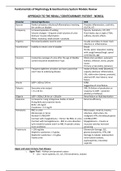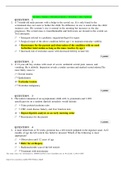Lecture 8 (BOOK) – Membrane
transport (Thunnissen)
Chapter 11 page 597-611
CH11 Membrane Transport of Small Molecules and the
Electrical Properties of Membranes
Principles of membrane transport
Because of its hydrophobic interior, the lipid bilayer of cell membranes restricts the
passage of most polar molecules. In general, the smaller the molecule and the more
hydrophobic, or nonpolar, it is, the more easily it will diffuse across a lipid bilayer.
Like lipid bilayers, cell membranes allow small nonpolar molecules to permeate by
diffusion. Cell membranes however, also have to allow the passage of various polar
molecules. This is done by special membrane transport proteins that transfer such
solutes across cell membranes. The two major classes of membrane transport
proteins are transporters (bind to solute and undergo a series of conformational
changes) and channels (interact with solute more weakly, and form continues pores
which can open and close).
All channels and many transporters allow solutes to cross the membrane only passively, called
passive transport. In case of an uncharged molecule, the concentration gradient drives passive
transport and determines direction. If the solute carries a net charge, both concentration gradient
and the electrical potential difference across the membrane (membrane potential) influence its
transport. These two together is called the electrochemical gradient.
Almost all plasma membranes have an electrical potential across them with the inside usually
negative with respect to the outside, this also favours the entry of positively charged ions but
opposes the entry of negatively charged ions.
In contrast to passive transport, active transport is mediated by transporters whose pumping activity
is directional because it is coupled to a source of metabolic energy.
Summary
Lipid bilayers are virtually impermeable to most polar molecules. To transport small water-soluble
molecules into or out of cells or intracellular membrane-enclosed compartments, cell membranes
contain various membrane transport proteins, each of which is responsible for transferring a
particular solute or class of solutes across the membrane. There are two classes of membrane
transport proteins—transporters and channels. Both form protein pathways across the lipid bilayer.
Whereas transmembrane movement mediated by transporters can be either active or passive, solute
flow through channel proteins is always passive. Both active and passive ion transport is influenced by
the ion’s concentration gradient and the membrane potential—that is, its electrochemical gradient.
Transporters and active membrane transport
Each type of transporter has one or more specific binding sites for its substrate. The transition occurs
through an intermediate state in which the solute is inaccessible (occluded), from either side of the
membrane. When the transporter is saturated, the rate of transport is maximal —> Vmax. The Vmax
measures the rate at which the carrier can flip between its conformational states. In addition, each
, transporter has a characteristic affinity for its solute, reflected in the Km of the reaction, which is
equal to the [solute] when the transport rate is half its maximum value.
Cells carry out active transport in three main ways:
1. Coupled transporters harness the energy stored in concentration gradients to couple the
uphill transport of one solute across the membrane to the downhill transport of another.
2. ATP-driven pumps couple uphill transport to the hydrolysis of ATP.
3. Light- or redox-driven pumps, are known in bacteria, archaea, mitochondria and
chloroplasts, and couple uphill transport to an input of energy fro light, or from redox
reactions.
Ion-concentration gradient driven active transport
Uniporters are transporters that passively mediate the movement of a single solute from one side of
the membrane to the other, at a rate determined by their V max and Km. This is in contrast to coupled
transporters in which the transport of one solute strictly depends on the transport of a second.
Coupled transport involves either the simultaneous transfer of a second solute in the same direction,
performed by symporters (also called co-transporters), or the transfer of a second solute in the
opposite direction, performed by antiporters (also called exchangers):
The tight coupling of two solutes allows the transporter to harvest the energy stored in the
electrochemical gradient or one coloured (typically an inorganic ion) to transport the other. In the
plasma membrane of animal cells, Na+ is the usual co-transported ion because its electrochemical
gradient provides a large driving force for the active transport of a second molecule. The Na+ that
enters the cells are pumped out by ATP-driven NA-K pumps in the plasma membrane which (by
maintaining Na+ gradient) indirectly drives the coupled receptor. Such ion-driven coupled
transporters as just described are said to mediate secondary active transport. In contrast, ATP-driven
pumps are said to mediate primary active transport because in these the free energy of ATP
hydrolysis is used to directly drive the transport of a solute against its concentration gradient.
transport (Thunnissen)
Chapter 11 page 597-611
CH11 Membrane Transport of Small Molecules and the
Electrical Properties of Membranes
Principles of membrane transport
Because of its hydrophobic interior, the lipid bilayer of cell membranes restricts the
passage of most polar molecules. In general, the smaller the molecule and the more
hydrophobic, or nonpolar, it is, the more easily it will diffuse across a lipid bilayer.
Like lipid bilayers, cell membranes allow small nonpolar molecules to permeate by
diffusion. Cell membranes however, also have to allow the passage of various polar
molecules. This is done by special membrane transport proteins that transfer such
solutes across cell membranes. The two major classes of membrane transport
proteins are transporters (bind to solute and undergo a series of conformational
changes) and channels (interact with solute more weakly, and form continues pores
which can open and close).
All channels and many transporters allow solutes to cross the membrane only passively, called
passive transport. In case of an uncharged molecule, the concentration gradient drives passive
transport and determines direction. If the solute carries a net charge, both concentration gradient
and the electrical potential difference across the membrane (membrane potential) influence its
transport. These two together is called the electrochemical gradient.
Almost all plasma membranes have an electrical potential across them with the inside usually
negative with respect to the outside, this also favours the entry of positively charged ions but
opposes the entry of negatively charged ions.
In contrast to passive transport, active transport is mediated by transporters whose pumping activity
is directional because it is coupled to a source of metabolic energy.
Summary
Lipid bilayers are virtually impermeable to most polar molecules. To transport small water-soluble
molecules into or out of cells or intracellular membrane-enclosed compartments, cell membranes
contain various membrane transport proteins, each of which is responsible for transferring a
particular solute or class of solutes across the membrane. There are two classes of membrane
transport proteins—transporters and channels. Both form protein pathways across the lipid bilayer.
Whereas transmembrane movement mediated by transporters can be either active or passive, solute
flow through channel proteins is always passive. Both active and passive ion transport is influenced by
the ion’s concentration gradient and the membrane potential—that is, its electrochemical gradient.
Transporters and active membrane transport
Each type of transporter has one or more specific binding sites for its substrate. The transition occurs
through an intermediate state in which the solute is inaccessible (occluded), from either side of the
membrane. When the transporter is saturated, the rate of transport is maximal —> Vmax. The Vmax
measures the rate at which the carrier can flip between its conformational states. In addition, each
, transporter has a characteristic affinity for its solute, reflected in the Km of the reaction, which is
equal to the [solute] when the transport rate is half its maximum value.
Cells carry out active transport in three main ways:
1. Coupled transporters harness the energy stored in concentration gradients to couple the
uphill transport of one solute across the membrane to the downhill transport of another.
2. ATP-driven pumps couple uphill transport to the hydrolysis of ATP.
3. Light- or redox-driven pumps, are known in bacteria, archaea, mitochondria and
chloroplasts, and couple uphill transport to an input of energy fro light, or from redox
reactions.
Ion-concentration gradient driven active transport
Uniporters are transporters that passively mediate the movement of a single solute from one side of
the membrane to the other, at a rate determined by their V max and Km. This is in contrast to coupled
transporters in which the transport of one solute strictly depends on the transport of a second.
Coupled transport involves either the simultaneous transfer of a second solute in the same direction,
performed by symporters (also called co-transporters), or the transfer of a second solute in the
opposite direction, performed by antiporters (also called exchangers):
The tight coupling of two solutes allows the transporter to harvest the energy stored in the
electrochemical gradient or one coloured (typically an inorganic ion) to transport the other. In the
plasma membrane of animal cells, Na+ is the usual co-transported ion because its electrochemical
gradient provides a large driving force for the active transport of a second molecule. The Na+ that
enters the cells are pumped out by ATP-driven NA-K pumps in the plasma membrane which (by
maintaining Na+ gradient) indirectly drives the coupled receptor. Such ion-driven coupled
transporters as just described are said to mediate secondary active transport. In contrast, ATP-driven
pumps are said to mediate primary active transport because in these the free energy of ATP
hydrolysis is used to directly drive the transport of a solute against its concentration gradient.












